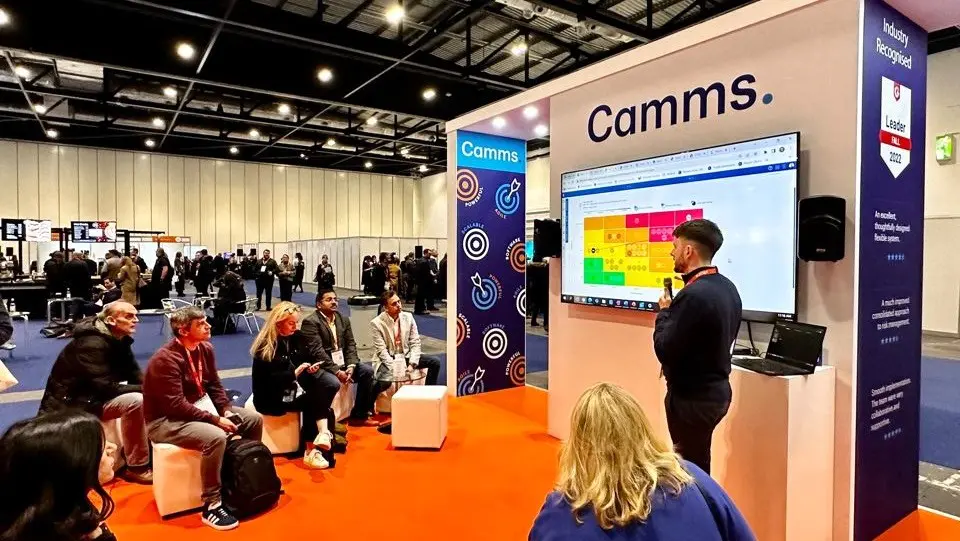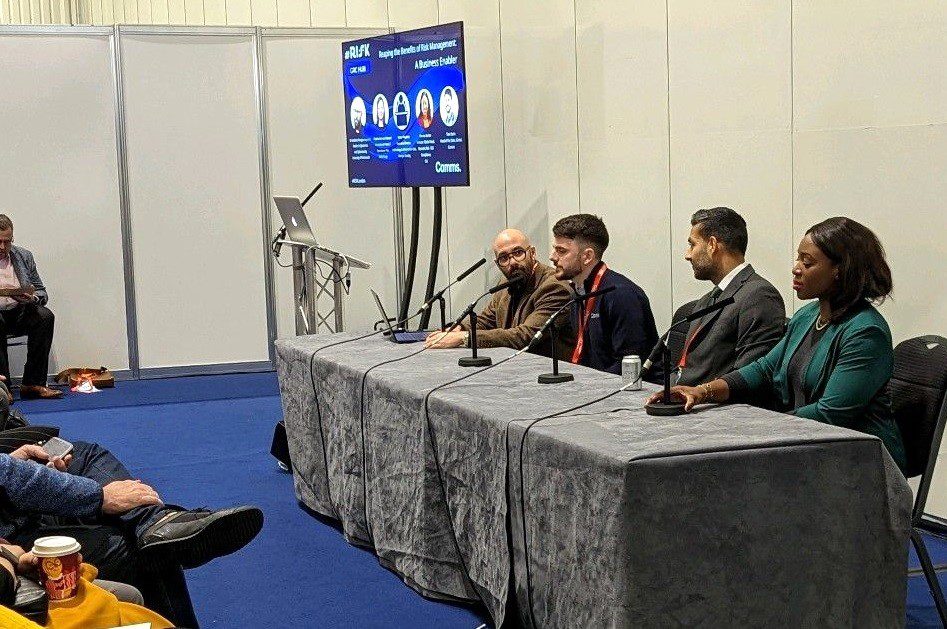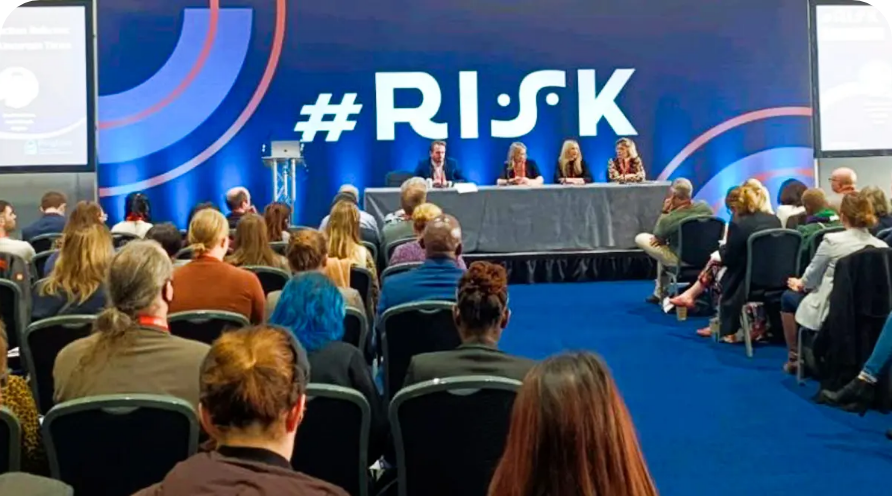#Risk’s debut was a resounding success! With thousands of risk professionals and hundreds of speakers and exhibitors attending the inaugural expo at ExCeL London on 16th & 17th November to hear expert guidance, insight, and debate – and Camms were in the thick of it!
From informative presentations and engaging panel discussions to keynotes delivered by high-profile speakers, the largest risk expo in Europe brought the whole risk community together under one roof. The philosophy behind #RISK was to provide a platform for practitioners to meet, learn and consider a more collaborative approach with an aim to ‘make risk everyone’s business.’
#RISK addressed the big issues via five content hubs – GRC, ESG, Data Protection & Privacy, Cyber Security, and Financial Risk. Day One included a keynote from Journalist and Author, Oliver Bullough on: ‘How Britain Became the Servant of Tycoons, Tax Dodgers, Kleptocrats and Criminals. ‘Day Two lived up to its promise of being an equally successful one and saw former Politician and Academic, Rory Stewart discuss ‘War in Europe, the Rise of Populism and Geopolitical Risk.’
Here are some key takeaways that emerged at #RISK:
The Role of the Risk Professional is Evolving
The risk landscape has changed irrevocably over the past couple of years – and so has the role of the risk professional.
While the pivotal role of a Risk Manager/professional is certainly not a new position, the challenges around regulations, compliance and security risks are constantly evolving. Almost every panel discussion highlighted the requirement for today’s Risk Managers to have access to analytical data – along with the IT, analytical, networking, and critical thinking skills to leverage data across the enterprise to make significant improvements in risk-based decision-making, organisational performance, risk awareness, and digital transformation.
At its core, accurate risk data dramatically facilitates strategic decision-making and better outcomes for organisations – which in turn leads to improved support across operations. An integrated approach to GRC supported by a powerful tool that enables data integration can equip Risk Managers with the high-quality data and insights they need to support informed, risk-based decision-making that aligns with organisational objectives.
The Relationship Between Enterprise Risk and Enterprise Performance
Another overarching theme that emerged among many of the presenters was the need to link risk to enterprise performance.
In today’s business environment, boards realise they must tolerate some level of risk in order to grow the business, improve enterprise performance, and achieve strategic objectives. Boards and senior management must be able to leverage risk data to support them to make decisions that may impact performance.
Integrating risk management activities into the rest of the business as part of enterprise performance and strategic planning can not only help the Board understand the right risks to take, but it can also generate better information to aid decision-making – helping meet business objectives more effectively.
The need for risk to be discussed at a Board level was also recognised. At the very heart of it, the Board’s mission should be to assess and supervise risks as well as steer the organisation towards major opportunities. Yet this requires an openness to talk about risk and for Board members to be proficient in risk knowledge and understand risk appetite to help them decide which risks can be tolerated and which cannot.
Risk Managers should be at liberty to approach the Board to present compliance gaps and provide an overview of the risks the business is facing. This will enable them to receive the input they need regarding how to allocate time, budget, and resources to address unwanted risk – and to clarify the gaps and residual risks the organisation is willing to accept.
Building a Risk-Aware Culture
Risk culture is what weaves the business of ‘managing risk’ into the everyday routines of all employees. With more eyes and ears on the lookout for emerging risks, a business is much less likely to be blindsided by undetected vulnerability – and that’s a significant competitive advantage for any organisation.
Risk culture is built from the top down and requires engagement from all levels of an organisation. A poor culture can undermine even the best-designed risk framework and take decades to repair. It’s clear moving forward, organisations need to steer away from the mentality of, ‘that’s how we have always done it’ and need to start asking the question ‘If there is a slight risk to the business, can we do it in a different way – or are we willing to risk the consequences.’
Disparate Systems and Manual Spreadsheets Remain a Bane for Many Businesses
Spreadsheets to manage risk was still a core problem for many organisations. It was apparent through countless conversations with risk delegates that many organisations rely on disparate systems, spreadsheets, or other manual risk management processes to manage ERM.
With effective risk management never having been more critical, spreadsheets present only crippling limitations including manual report preparation, a lack of automation, and countless security and accuracy risks. In addition, many organisations were using outdated software and disparate systems resulting in siloed data, poor user interface, and limited data analysis, dashboard automation, and reporting options.
Enterprise risk management can be made much easier through a new generation cloud-based risk management software such as Camms.Risk, and can provide a significant step up from spreadsheets or older software solutions. It effectively automates the risk management workflow and provides analytics and smart visualisations while being flexible, timely, and easy to use. To learn more, check out our blog and on-demand webinar explaining the benefits SaaS solutions can provide to your risk management approach.
The ESG Buzz is Real
ESG has evolved from a ‘nice-to-have’ to a ‘must-have’ for organisations – the buzz around ESG was very much real at #RISK. It’s evident that the investor community in particular now considers Environmental, Social and Governance reporting as a major factor for determining the performance of an organisation.
The ESG theme explored the key environmental, social and governance challenges with broad philosophical discussions accompanied by hands-on guidance on the realities of ESG data and reporting requirements.
Several sessions centred around the B-Corp movement, an ethical certification scheme led by businesses seeking to demonstrate their commitment to sustainability and social justice. The call for the ESG revolution to further consider ‘sustainable governance’ and ‘corporate integrity’ was also widely discussed.
Panellists also pointed out that ESG starts with an organisation’s company values, policies and code-of-conduct – eventually building into environmental regulations and legislation. The fact that ESG has now evolved from a mere box-ticking exercise into making a difference for your business and our world was acknowledged. ESG creates sustained outcomes that drive value and fuel growth – while strengthening our overall environment and society as a whole.
In terms of governance, whistleblowing arrangements and their critical role in risk and compliance were also hot topics. The need for fostering a strong speak-up culture and committing to effective whistle-blower protection to support and empower employees in ‘blowing the whistle’ on corruption, fraud or wrongdoing was apparent and encouraged.
Michael Rasmussen Chaired the GRC Theatre
 It was also great to have internationally recognised GRC analyst and pundit, Michael Rasmussen chairing the GRC theatre. Michael’s opening keynote speech, ‘Aligning the Scattered Silos of Risk’, cut to the very heart of the #RISK series ethos, and really explored how to build a culture of trust and transparency among your team to reduce risk and achieve business objectives. He also explored high-level topics around compliance management, corporate ethics, and risk reduction. Michael, quoting Theodor Roosevelt, noted that risk is like fire, if controlled it will help, if uncontrolled it will rise up and destroy you. He went on to point out that to succeed in the modern risk landscape, organisations must be able to see both the tree (individual risk) and the forest (the interconnectedness of risk and objectives).
It was also great to have internationally recognised GRC analyst and pundit, Michael Rasmussen chairing the GRC theatre. Michael’s opening keynote speech, ‘Aligning the Scattered Silos of Risk’, cut to the very heart of the #RISK series ethos, and really explored how to build a culture of trust and transparency among your team to reduce risk and achieve business objectives. He also explored high-level topics around compliance management, corporate ethics, and risk reduction. Michael, quoting Theodor Roosevelt, noted that risk is like fire, if controlled it will help, if uncontrolled it will rise up and destroy you. He went on to point out that to succeed in the modern risk landscape, organisations must be able to see both the tree (individual risk) and the forest (the interconnectedness of risk and objectives).
Meanwhile at the Camms Booth…

Camms had a lot going on at our booth over the course of the two-day event including a series of ‘software teaser’ demos in our ‘mini theatre’ to give attendees a taster of some of our great software capabilities, plus 1-2-1 chats and live demos. Our team of experts got the opportunity to engage in great conversations with numerous risk professionals, discussing their current approaches to managing GRC and sharing insights on how Camms can best support them in their journey to GRC success. We also had an exciting prize draw for a brand-new Samsung Galaxy Tablet and our giveaways – including free socks, coffee cups, and pens – were flying off the stand.

On day one our Head of Pre-Sales, Tom Kerin, had the opportunity to appear in a panel discussion titled, ‘Reaping the Benefits of Risk Management: A Business Enabler’. He was joined by the crème de la crème of the financial sector, Ollythia Bernard-Stewart, International Head of Operations Risk of Wells Fargo, Kishan Majithia, Executive Director, Technology & Information Risk at Morgan Stanley, and Abisola Barber, Director and Global Head of Thematic Risk and ICG Compliance at Citi.
The well-received discussion explored how revolutions in work patterns, technology, and society are changing business models – with regulations struggling to keep up. The panel shared their up-to-date knowledge of the risk landscape, provided guidance on how to build a risk-conscious culture, and shared valuable insight into which risk management tools organisations need to utilise to ensure their bets pay off.
Conclusion
#RISK in London by GRC World Forums was an amazing event – with packed theatres with standing room only for many of the key presentations. Our team of experts had the opportunity to engage in great conversations on the evolving risk landscape and how Camms supports organisations – large and small – to reduce risk, remain compliant, and optimise business growth.
“#RISK was a fantastic platform that reinforced our ideas about GRC, Security, Privacy, ESG, Fin Crime, Fraud, Compliance & Risk Culture. It provided a wonderful opportunity to meet potential partners and learn about the key risk & compliance challenges facing organisations – enabling us to consider the steps we can take to help organisations work collaboratively to manage and mitigate risk.” – Tom Kerin, Head of Pre-Sales.
The fun is not over yet! Save your seat for this upcoming webinar in association with #RISK on ‘Why Enterprise Performance should be at the Heart of GRC’ where the Father of GRC, Michael Rasmussen will share his key takeaways from the #RISK event and provide his thoughts on why enterprise performance and strategic objectives should be the driving force behind your GRC programme.
Today’s Business leaders must consider and respond to more risks than ever before, and many businesses are having to transition from fragmented risk management to an integrated holistic approach. For more information on how Camms can help you implement an integrated approach to Governance, Risk & Compliance across your organisation reach out for a demo.





